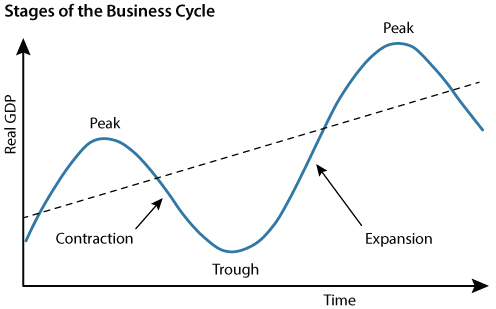- Español
- English
- Italiano
- Français
Share
The business cycle is, perhaps, the most important macroeconomic concept to comprehend, as a comprehensive understanding of it - also referred to as the economic cycle - will help to unlock an understanding of how data should be interpreted, how policy tends to be made, and, ultimately, how markets are likely to trade as a result.
At its core, the business cycle refers to the fluctuations, at a broad level, between economic expansion, and contraction, helping to define the overall state of the economy at a given time. Many indicators can be used in an attempt to time the economic cycle, including - GDP, interest rates, employment, and spending.
Typically, the business cycle is split into the four stages below. However, it is important to note that no two cycles are identical; the length of expansions has varied wildly over time, as has the length of recessions/depressions, while the amplitude of the peaks and troughs in the cycle also varies over time.
Cycle Stages
- Expansion: During this phase of the cycle, the economy experiences a rapid pace of growth, with interest rates tending to be relatively low, as output increases across most parts of the economy. Employment tends to increase, and earnings - as well as corporate profits - begin to trend higher. This rise in earnings, coupled with an increase in the money supply, does however pose the risk of spurring higher inflation as the economy expands.
- Peak: The cycle’s peak is seen when growth hits its terminal velocity, a point at which various indicators of prices and economic output typically experience a period of stability, before correcting to the downside. This stage of the cycle often creates imbalances between supply and demand (of goods, services, and/or labour) which must ultimately be corrected.
- Contraction: The opposite phase to an economic expansion, and one where growth slows, employment falls, and prices either stagnate or decrease. Often, businesses are slow to adjust to such a contraction, leading to a surplus in supply of goods and services as demand deteriorates, contributing to the aforementioned downward pressure on prices. A contraction is often defined as a recession, technically only if it results in two consecutive quarterly contractions in GDP growth, and may deteriorate further into a depression if it becomes prolonged.
- Trough: The cycle’s trough is when economic growth bottoms out before an eventual recovery begins to take hold. This is the worst moment of the cycle for the economy, where spending and income are at their lowest level, and the labour market has dramatically weakened, with hiring coming to a halt, and unemployment having risen substantially. Following a trough, the economy will begin to recover, and re-enter the expansion phase.
A graphical representation of this cycle can be found below, courtesy of the St Louis Fed:

Preview
Related articles
El material proporcionado aquí no ha sido preparado de acuerdo con los requisitos legales diseñados para promover la independencia de la investigación de inversiones y, por lo tanto, se considera una comunicación de marketing. Aunque no está sujeto a ninguna prohibición de negociación antes de la difusión de la investigación de inversiones, no buscaremos obtener ninguna ventaja antes de proporcionarla a nuestros clientes.
Pepperstone no garantiza que el material proporcionado aquí sea preciso, actual o completo, por lo tanto, no debe confiarse en él como tal. La información, ya sea de un tercero o no, no debe considerarse como una recomendación; o una oferta de compra o venta; o la solicitud de una oferta de compra o venta de cualquier valor, producto financiero o instrumento; o para participar en una estrategia de negociación en particular. No tiene en cuenta la situación financiera u objetivos de inversión de los lectores. Recomendamos a los lectores de este contenido que busquen su propio asesoramiento. Sin la aprobación de Pepperstone, no está permitida la reproducción o redistribución de esta información.
Pepperstone no garantiza que el material proporcionado aquí sea preciso, actual o completo, por lo tanto, no debe confiarse en él como tal. La información, ya sea de un tercero o no, no debe considerarse como una recomendación; o una oferta de compra o venta; o la solicitud de una oferta de compra o venta de cualquier valor, producto financiero o instrumento; o para participar en una estrategia de negociación en particular. No tiene en cuenta la situación financiera u objetivos de inversión de los lectores. Recomendamos a los lectores de este contenido que busquen su propio asesoramiento. Sin la aprobación de Pepperstone, no está permitida la reproducción o redistribución de esta información.








